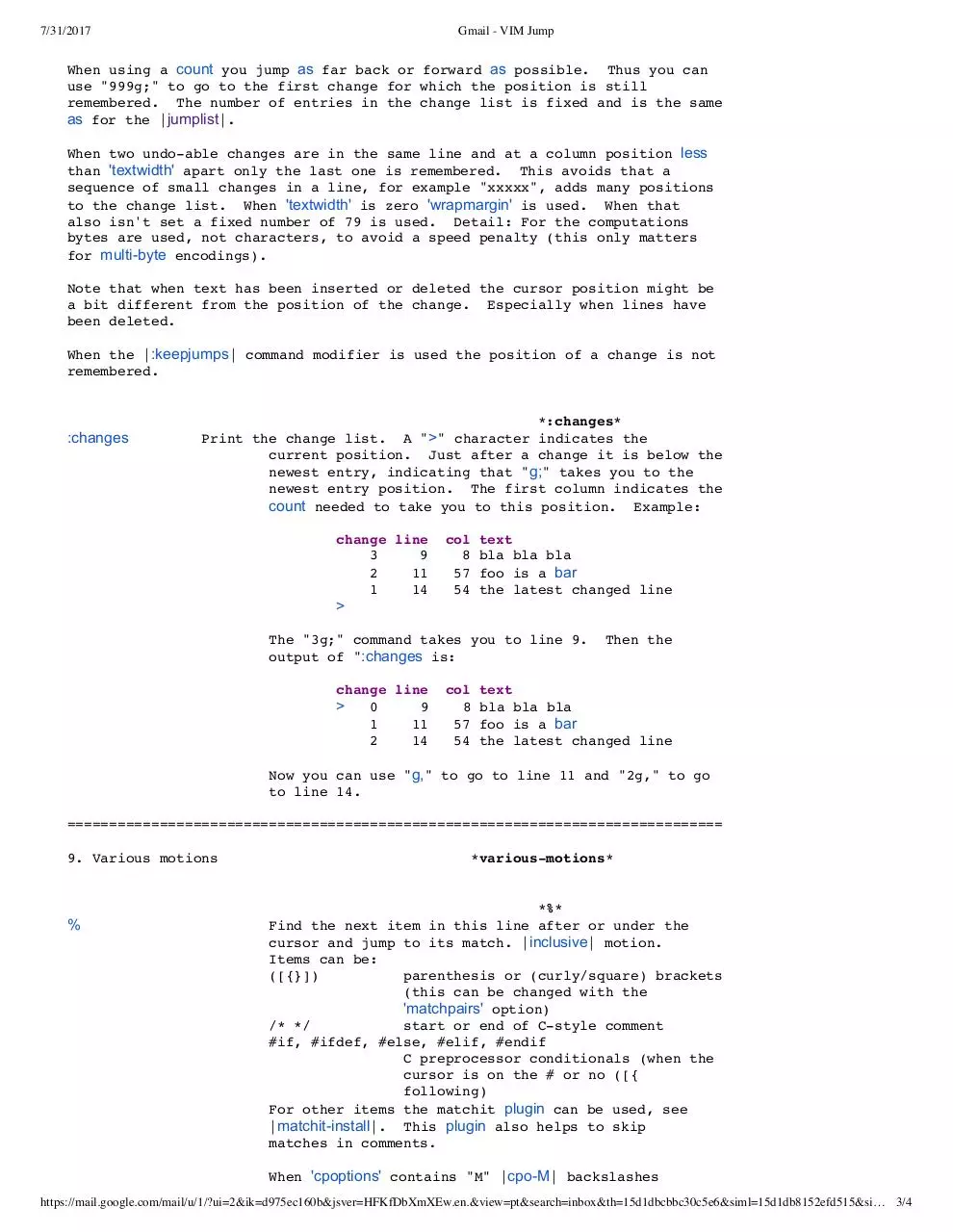VIM Jump help (PDF)
File information
This PDF 1.4 document has been generated by Mozilla/5.0 (Macintosh; Intel Mac OS X 10_12_5) AppleWebKit/537.36 (KHTML, like Gecko) Chrome/59.0.3071.115 Safari/537.36 / Skia/PDF m59, and has been sent on pdf-archive.com on 31/07/2017 at 15:56, from IP address 50.206.x.x.
The current document download page has been viewed 235 times.
File size: 194.72 KB (4 pages).
Privacy: public file




File preview
7/31/2017
Gmail - VIM Jump
Gal Fisher <galfisher6@gmail.com>
VIM Jump
3 messages
Gal Fisher <galfisher6@gmail.com>
To: Gal Fisher <galfisher6@gmail.com>
8. Jumps
Fri, Jul 7, 2017 at 11:43 AM
*jump-motions*
A "jump" is one of the following commands: "'"', "`", "G", "/", "?", "n",
"N", "%", "(", ")", "[[", "]]", "{", "}", ":s", ":tag", "L", "M", "H" and
the commands that start editing a new file. If you make the cursor "jump"
with one of these commands, the position of the cursor before the jump is
remembered. You can return to that position with the "''"' and "``" command,
unless the line containing that position was changed or deleted.
*CTRL-O*
Go to [count] Older cursor position in jump list
(not a motion command). {not in Vi}
{not available without the |+jumplist| feature}
CTRLO
<Tab>
CTRLI
or
*CTRL-I* *<Tab>*
Go to [count] newer cursor position in jump list
(not a motion command).
In a |quickfixwindow| it takes you to the position of
the error under the cursor.
{not in Vi}
{not available without the |+jumplist| feature}
*:ju* *:jumps*
Print the jump list (not a motion command). {not in
Vi} {not available without the |+jumplist| feature}
:ju[mps]
*jumplist*
Jumps are remembered in a jump list. With the CTRLO and CTRLI command you
can go to cursor positions before older jumps, and back again. Thus you can
move up and down the list. There is a separate jump list for each window.
The maximum number of entries is fixed at 100.
{not available without the |+jumplist| feature}
For example, after three jump commands you have this jump list:
jump line
3
1
2
70
1 1154
col
0
0
23
file/text
some text
another line
end.
>
The "file/text" column shows the file name, or the text at the jump if it is
in the current file (an indent is removed and a long line is truncated to fit
in the window).
You are currently in line 1167. If you then use the CTRLO command, the
cursor is put in line 1154. This results in:
jump line
2
1
1
70
col file/text
0 some text
0 another line
https://mail.google.com/mail/u/1/?ui=2&ik=d975ec160b&jsver=HFKfDbXmXEw.en.&view=pt&search=inbox&th=15d1dbcbbc30c5e6&siml=15d1db8152efd515&si… 1/4
7/31/2017
>
Gmail - VIM Jump
0
1
1154
1167
23 end.
0 foo bar
The pointer will be set at the last used jump position. The next CTRLO
command will use the entry above it, the next CTRLI command will use the
entry below it. If the pointer is below the last entry, this indicates that
you did not use a CTRLI or CTRLO before. In this case the CTRLO command
will cause the cursor position to be added to the jump list, so you can get
back to the position before the CTRLO. In this case this is line 1167.
With more CTRLO commands you will go to lines 70 and 1. If you use CTRLI
you can go back to 1154 and 1167 again. Note that the number in the "jump"
column indicates the count for the CTRLO or CTRLI command that takes you to
this position.
If you use a jump command, the current line number is inserted at the end of
the jump list. If the same line was already in the jump list, it is removed.
The result is that when repeating CTRLO you will get back to old positions
only once.
When the |:keepjumps| command modifier is used, jumps are not stored in the
jumplist. Jumps are also not stored in other cases, e.g., in a |:global|
command. You can explicitly add a jump by setting the '' mark.
After the CTRLO command that got you into line 1154 you could give another
jump command (e.g., "G"). The jump list would then become:
jump line
4
1
3
70
2 1167
1 1154
col
0
0
0
23
file/text
some text
another line
foo bar
end.
>
The line numbers will be adjusted for deleted and inserted lines.
if you stop editing a file without writing, like with ":n!".
This fails
When you split a window, the jumplist will be copied to the new window.
If you have included the '' item in the 'viminfo' option the jumplist will be
stored in the viminfo file and restored when starting Vim.
CHANGE LIST JUMPS
*changelist* *change-list-jumps* *E664*
When making a change the cursor position is remembered. One position is
remembered for every change that can be undone, unless it is close to a
previous change. Two commands can be used to jump to positions of changes,
also those that have been undone:
g;
g,
*g;* *E662*
Go to [count] older position in change list.
If [count] is larger than the number of older change
positions go to the oldest change.
If there is no older change an error message is given.
(not a motion command)
{not in Vi}
{not available without the |+jumplist| feature}
*g,* *E663*
Go to [count] newer cursor position in change list.
Just like |g;| but in the opposite direction.
(not a motion command)
{not in Vi}
{not available without the |+jumplist| feature}
https://mail.google.com/mail/u/1/?ui=2&ik=d975ec160b&jsver=HFKfDbXmXEw.en.&view=pt&search=inbox&th=15d1dbcbbc30c5e6&siml=15d1db8152efd515&si… 2/4
7/31/2017
Gmail - VIM Jump
When using a count you jump as far back or forward as possible. Thus you can
use "999g;" to go to the first change for which the position is still
remembered. The number of entries in the change list is fixed and is the same
as for the |jumplist|.
When two undo-able changes are in the same line and at a column position less
than 'textwidth' apart only the last one is remembered. This avoids that a
sequence of small changes in a line, for example "xxxxx", adds many positions
to the change list. When 'textwidth' is zero 'wrapmargin' is used. When that
also isn't set a fixed number of 79 is used. Detail: For the computations
bytes are used, not characters, to avoid a speed penalty (this only matters
for multibyte encodings).
Note that when text has been inserted or deleted the cursor position might be
a bit different from the position of the change. Especially when lines have
been deleted.
When the |:keepjumps| command modifier is used the position of a change is not
remembered.
:changes
*:changes*
Print the change list. A ">" character indicates the
current position. Just after a change it is below the
newest entry, indicating that "g;" takes you to the
newest entry position. The first column indicates the
count needed to take you to this position. Example:
change line
3
9
2
11
1
14
col
8
57
54
text
bla bla bla
foo is a bar
the latest changed line
>
The "3g;" command takes you to line 9.
output of ":changes is:
change line
0
9
1
11
2
14
>
col
8
57
54
Then the
text
bla bla bla
foo is a bar
the latest changed line
Now you can use "g," to go to line 11 and "2g," to go
to line 14.
==============================================================================
9. Various motions
%
*various-motions*
*%*
Find the next item in this line after or under the
cursor and jump to its match. |inclusive| motion.
Items can be:
([{}])
parenthesis or (curly/square) brackets
(this can be changed with the
'matchpairs' option)
/* */
start or end of C-style comment
#if, #ifdef, #else, #elif, #endif
C preprocessor conditionals (when the
cursor is on the # or no ([{
following)
For other items the matchit plugin can be used, see
|matchitinstall|. This plugin also helps to skip
matches in comments.
When 'cpoptions' contains "M" |cpoM| backslashes
https://mail.google.com/mail/u/1/?ui=2&ik=d975ec160b&jsver=HFKfDbXmXEw.en.&view=pt&search=inbox&th=15d1dbcbbc30c5e6&siml=15d1db8152efd515&si… 3/4
7/31/2017
Gmail - VIM Jump
before parens and braces are ignored. Without "M" the
number of backslashes matters: an even number doesn't
match with an odd number. Thus in "( \) )" and "\( (
\)" the first and last parenthesis match.
When the '%' character is not present in 'cpoptions'
|cpo%|, parens and braces inside double quotes are
ignored, unless the number of parens/braces in a line
is uneven and this line and the previous one does not
end in a backslash. '(', '{', '[', ']', '}' and ')'
are also ignored (parens and braces inside single
quotes). Note that this works fine for C, but not for
Perl, where single quotes are used for strings.
Nothing special is done for matches in comments. You
can either use the matchit plugin |matchitinstall| or
put quotes around matches.
No count is allowed, {count}% jumps to a line {count}
percentage down the file |N%|. Using '%' on
#if/#else/#endif makes the movement linewise.
Gal Fisher <galfisher6@gmail.com>
To: Gal Fisher <galfisher6@gmail.com>
Fri, Jul 7, 2017 at 11:46 AM
Use :changes
[Quoted text hidden]
Gal Fisher <galfisher6@gmail.com>
To: Gal Fisher <galfisher6@gmail.com>
Fri, Jul 7, 2017 at 11:48 AM
Use :jumps
[Quoted text hidden]
https://mail.google.com/mail/u/1/?ui=2&ik=d975ec160b&jsver=HFKfDbXmXEw.en.&view=pt&search=inbox&th=15d1dbcbbc30c5e6&siml=15d1db8152efd515&si… 4/4
Download VIM Jump help
VIM Jump help.pdf (PDF, 194.72 KB)
Download PDF
Share this file on social networks
Link to this page
Permanent link
Use the permanent link to the download page to share your document on Facebook, Twitter, LinkedIn, or directly with a contact by e-Mail, Messenger, Whatsapp, Line..
Short link
Use the short link to share your document on Twitter or by text message (SMS)
HTML Code
Copy the following HTML code to share your document on a Website or Blog
QR Code to this page

This file has been shared publicly by a user of PDF Archive.
Document ID: 0000630997.